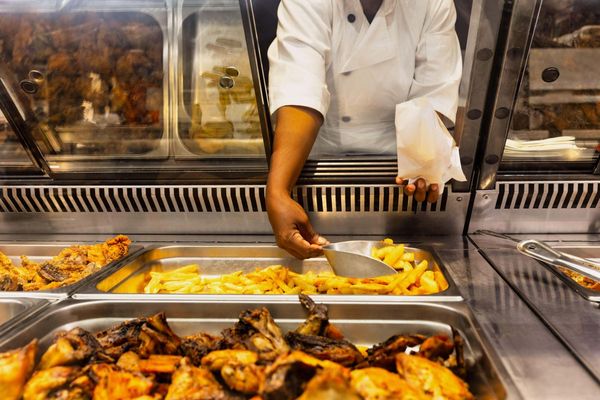In June, a veterinary clinic in Bairnsdale, in eastern Victoria, started seeing pet dogs with a mystery illness — within days they were inundated with sick animals all suffering the same symptoms.
Soon after they called the authorities.
All the dogs were suffering from severe liver toxicity. Eight died.
Now, staff at the Main Street Veterinary Clinic, ground zero for the worst pet food contamination in Victoria's history, have told of the stress and their anguish during the outbreak that resulted in the death of 26 dogs across the state.
"I haven't experienced anything like that before. It was challenging and exhausting," veterinary nurse Louise South said.
Sixty-eight dogs across the state were recorded by Victorian authorities as having suffered liver problems after eating contaminated pet food from the Maffra District Knackery.
Most of the dog owners thought they were buying "premium beef" and were shocked when toxicology testing revealed the pet food contained horse meat contaminated by the toxin indospicine, known for causing liver failure in dogs.
The toxin is found in several native indigofera plant species that only grow in northern Australia.
The discovery of indospicine led to an investigation spanning two states to try and find out how horses that had eaten the plant ended up in Gippsland.
Vets struggle to diagnose cause
Late in June, still in the early days of the crisis, veterinarian Durelle Esnouf said staff scrambled to work out what was making so many dogs sick.
Originally they thought it could have been a rare bacterial infection known as leptospirosis, which could also cause liver failure in dogs.
With the knowledge, that the zoonotic disease could be transmitted to humans and other animals vet clinic staff were forced to take drastic precautions while treating sick animals.
"The nurses who were stuck in the kennel room were in full personal protective equipment (PPE) for 12-hour shifts, trying to avoid getting any urine, any secretions or anything on them," Dr Esnouf said.
"In nearly 40 years of practice, I think it was by far the most stressful time I have ever dealt with."
Vet hospital hit capacity
The vet practice struggled to cope with the intensive workload. Dogs needed to be force-fed because many refused to eat or couldn't keep down the food they were given.
"One night we had in our hospital 11 liver cases on IV drips, or pretty much not eating and having to be fed supportive nutrition, either with a stomach tube or an oesophageal tube," Ms South said.
Another vet at the practice, Jade Hammer said they rostered on extra nurses over the weekend to cope with the workload.
"We almost got to the point of needing to transfer animals to other vet clinics because our hospital was at capacity at one point which hasn't happened before," he said.
"Most of the dogs that were in the hospital, requiring that intensive treatment, would not have survived without that type of care."
Ms South said dealing with distressed owners was also another stressful part of the job.
Eight of the dogs treated by the clinic died. The most recent was just last month when a 10-year-old French mastiff called Lily failed to recover despite beginning treatment in July.
Chantell Lawson, who describes Lily as "like another child" in her family, feels devastated.
She thanked clinic staff, where Lily had been a regular visitor after first being admitted four months ago suffering liver toxicity from the contaminated meat bought from a local store.
Ms Lawson is angry there wasn't a quicker recall of the pet food, which is not mandatory in Australia, and also that there's no national standard for pet food.
But most of all she just misses her pet.
"It's been a bit of a gut wrench," she said.
Clinic alerts authorities
The Main Street Veterinary Clinic was also responsible for calling Agriculture Victoria and alerting the department to the issue days after the first dog suffering liver problems was admitted.
Dr Hammer said they worked closely with Agriculture Victoria and meat processing regulator PrimeSafe during the investigation.
On July 3 they put up a Facebook post about the spate of dog illnesses and warned local residents the common link was pet food from the knackery. This led to another local retailer, Doggie Den, also warning its customers of the issue.
More than a month later the Agriculture Victoria investigation found the toxic pet food was linked to wild horses from the Northern Territory which had been processed at the Maffra District Knackery.
On August 19, the PrimeSafe and Agriculture Victoria investigation found no pet food manufacturing laws had been broken and there was no fault in the supply chain.
The case was closed with no charges laid.
Dr Esnouf said some vets who worked in northern Australia alerted her to the possibility of indospicine being a possible cause of the liver toxicity.
She said the disease was cruel, and sometimes the dogs died of neurological complications due to liver failure or pneumonia.
"It's not pleasant for these dogs at all," she said.
She wants pet food regulation to be reformed, something a Senate inquiry recommended in 2018, but has not been implemented.
"I think owners deserve to have some accountability with what's in the packet of food that they're buying their pitch," Dr Esnouf said.
And despite the bad batch of toxic meat being processed in May and June, they are still seeing new cases of the liver disease.
"We still see the odd owner that presents with a sick dog that hasn't been aware of the problem," she said.







